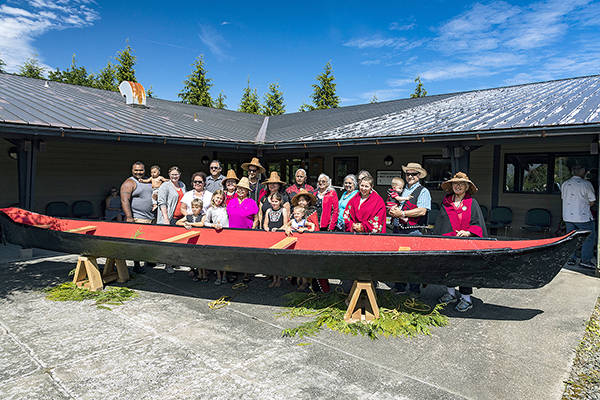by Christi Baron
Forks Forum Editor
In the culture of the Hoh, Quileute and other Northwest Tribes the significance of the cedar canoe is immeasurable. Since long before the first European explorers sailed near the shores of the Olympic Peninsula native canoes navigated the ocean and local waterways providing transportation, used in warfare as well as providing for the native peoples’ very existence, when used for fishing, sealing and whaling.
In a ceremony held July 8, 2017, at the Olympic Natural Resources Center in Forks, a canoe named the Viola was finally returned to the region in which it was carved. The journey has taken 50 years.
In the early 1960s, a canoe was carved by Viola Penn Riebe’s uncle William E. Penn. The canoe was given the name Viola. Then life happened, Riebe raised a family and at some point, the canoe left the families possession. It was eventually purchased by a Sequim resident, who knew nothing of its history, who then donated it to the Sequim Pioneer Memorial Park in Sequim. There it has sat on display until Pricilla Hudson got interested.
Hudson moved to Sequim about 10 years ago. She volunteered with several places including the Sequim Museum and Arts Center where she and others thrived on doing historical displays, presentations and city tours. Because Pioneer Memorial Park was the site of the first cemetery it was included in the tours.
That’s when the canoe at the Park caught her attention. “None of us could find information on the canoe. The scrapbooks of the Sequim Prairie Garden Club (started in 1948) did have the letter about the donation. But there was no history of the background of the canoe. So I just continued on with documenting the legacy,” Hudson said.
Hudson added, “Perhaps because I had been married to a Native Alaskan and lived on the Reserve I became immersed in Native American culture.” Hudson said that maybe it was her love of history that kept her searching for information on the canoe.
“My biggest reason for not giving up on the search though is wanting the community and those who come after me to know the history in this community. Why have an artifact on display if you don’t know the importance?” Hudson said.
Viola Riebe had found the canoe about 15 years ago but felt that since it was in the Sequim city park nothing could be done to get it back. She left the future of the canoe to prayer. Prayers were answered when there was a break in Hudson’s research in October 2016. Hudson discovered a story about a family looking to borrow the canoe for a family reunion. That story led her to Dixie Laudner, a payroll administrator for the Jamestown S’Klallam Tribe — and Viola Riebe’s daughter.
“When we found that the displayed canoe didn’t really belong to our town, the Garden Club Board enthusiastically guaranteed it go back to the real owner,” Hudson said.
Hudson said that she always took photos of the canoe with the design as the hallmark. “That’s why no tribal person or historical entity could identify it,” Hudson said. “I wanted to apply for a grant to restore it but was afraid to cover the design.”
Being a lover of history Hudson added, “I’m still working on the part of who painted the Indian like figures on the canoe as it was in an old scrapbook photo as plain.”
At the canoe gifting ceremony, the restored Viola was welcomed back with prayer, food, song, speeches, and thanks. The event was opened with a prayer by Bill Laubner. Vince Penn, Riebe’s nephew, was the Emcee.
Bernard Bormann, ONRC Director said, “First of all I’d like to accept this gift for ONRC, by welcoming the canoe home. We are so honored to look after it from this point forward, and to harness its power for learning and to symbolize the core mission of ONRC—strengthening connections between people and place, and helping people work together.” He added, “This canoe has inspired us to seek more tribal participation in our efforts.”
Dean Lisa Graumlich of the College of the Environment accepted the canoe along with Bormann. She talked about the historical significance and current need of strengthening the relationships with Tribes on the Peninsula.
She shared that the canoe represents a long standing focus on environmental protection and education, especially to continue improvements of stream, river, and ocean habitats.
“With this gift, from Viola Riebe, to the ONRC and the U of W we are reminded of our mission to continue in our discovery of the rapidly changing interaction between the earth’s environment and human activities that drive the research and teaching of the larger institution,” Graumlich said.
Since the arrival of the canoe at the ONRC, last April, it has had some restoration and is now ready for the public to enjoy. Restoration was done by Quileute Tribal members Tom Jackson and Chris Morganroth; three veterans from Sarge’s place Gary Jones, Robert Ball, and Jay Baker. ONRC staff Deric Kettel and Frank Hanson also participated and painting of the canoe was done by Cydney Craig-Hanson.
The story of the Viola is such an interesting one that Dr. Scott Macklin of the University of Washington Communications Department is making a documentary about it and Riebe’s daughter Marie Reibe is spearheading to get the story made into a children’s book.
For the native people of the Northwest Coast, the canoe was more than just a utilitarian object: it was and still is, a spiritual vessel that is an object of great respect.
Welcome home Viola.



